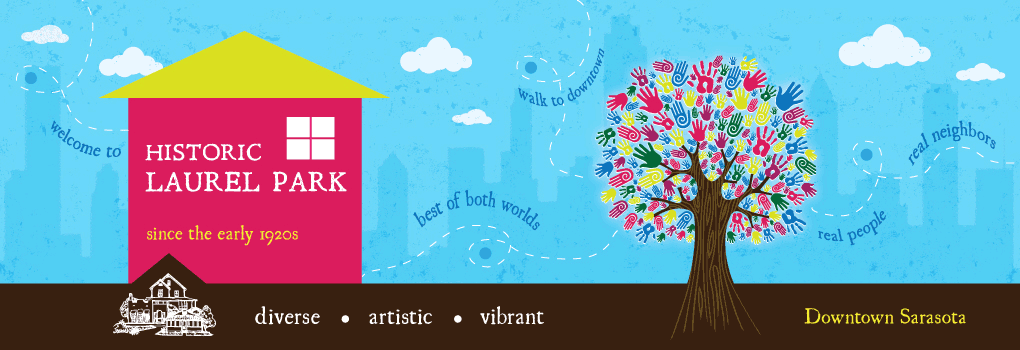History of the Laurel Park Neighborhood
In the 1900’s, the area that was to be known as Laurel Park was just beginning to be considered for development, as per a 1904 Sarasota land plat.
The Laurel Park neighborhood is actually a combination of several subdivisions created in the 1920s, including:
Laurel Park, the name:
The neighborhood association was formed by Jeffrey and Susan Harris in 1984. It was originally known as the Morrill Mound Neighborhood Association (click here for 1988 article about the early formation of the neighborhood).
The name “Laurel Park” was conceived by a committee of neighborhood residents in the 1990s. The committee would met at Steve and Nancy Long’s home (1902 Oak Street) to discuss many possible names that would create an identity for the neighborhood. The name Laurel Park won the day. The neighborhood association was renamed to the “Laurel Park Neighborhood Association”.
Laurel Park, the park:
This park was the result of a LPNA location committee which morphed into the Laurel Park Design Committee (consisting of Jack Notestein, Jolie McInnis, and Devin Rutkowski). This group made recommendations to the City about a neighborhood park which included the gazebo, play area, along with passive elements like landscaping and benches. The pocket park on Laurel Avenue between Ohio and Rawls was dedicated on Feb. 18, 1994. The landscape architect was Martin Alder.
Laurel Park, the residential character:
Around 2000, Andres Duany was hired to develop a plan for the downtown area. Several board members of the neighborhood association wanted Laurel Park to be included in that plan. This change in zoning would have meant an increase in density, three story houses, and the possibility of mixed used, among other changes. It also would have increased the likelihood of tearing down more historic homes. This was divisive. In the next election, the neighborhood voted for a slate of candidates who supported retaining the distinctly residential zoning of “RSM-9”. A multi-year discuss with the City followed. Since the process for replanning the downtown’s already well underway, it was difficult to later, and the topic continued to be divisive within the neighborhood. Ultimately those who wanted to preserve the residential neighborhood were successful, with the majority of the neighborhood backing them.
In 2003, as a result of the adoption of the new Downtown Master Plan, Laurel Park lost the ability to make comments on large projects built on the edge of the neighborhood. The neighborhood fought to reinstate the old system of Planning Board and City Commission hearings, but ultimately settled on a compromise, which became the Laurel Park Overlay District (or LPOD). Kate Lowman, a well regarded civic activist, shepherded the 3 year effort.
Tunes in the Park, the reconciliation:
This event was originally sponsored by the Goldman and McInnis families; the first event took place in November 2002. The purposes was to bring fellowship and restore the community to a common bond after the divisive fight regarding the RSM-9 non-commercial zoning. Since then, there have been parties in the park twice a year — typically in April and November.
Special thanks to long-time Laurel Park resident, Jude Levy for documenting the history of Laurel Park.

